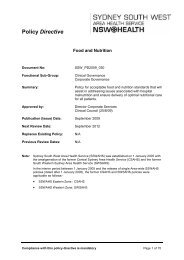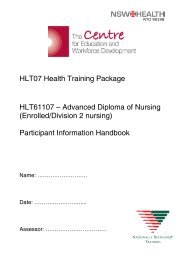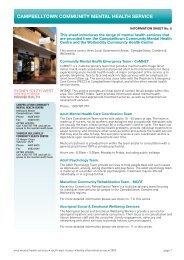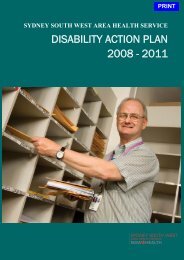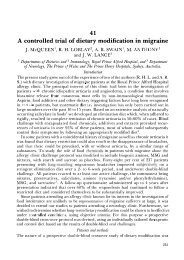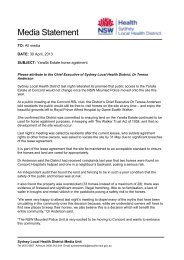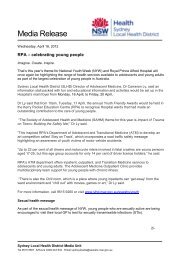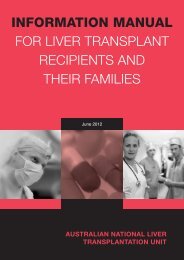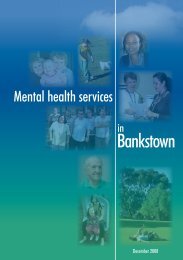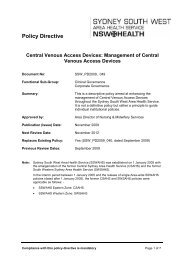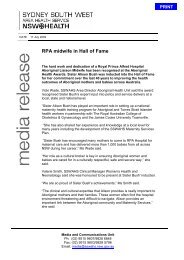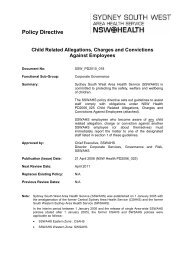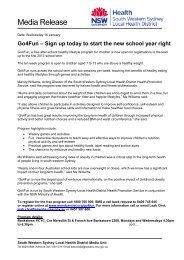Aged Care & Rehabilitation Clinical Services Plan 2007 – 2012
Aged Care & Rehabilitation Clinical Services Plan 2007 – 2012
Aged Care & Rehabilitation Clinical Services Plan 2007 – 2012
Create successful ePaper yourself
Turn your PDF publications into a flip-book with our unique Google optimized e-Paper software.
<strong>Aged</strong> <strong>Care</strong> & <strong>Rehabilitation</strong> <strong>Clinical</strong> Service <strong>Plan</strong> <strong>2007</strong> - <strong>2012</strong>due to the responsibility for the completion of the Boarding House Screening Tool for clientswishing to enter Boarding Houses; ACATs identified as one of the HACC ComprehensiveAssessment agencies under Regional HACC protocols; ACATs identified as the investigativeand assessment agency for HACC agencies in cases of suspected abuse of older people;changes to ACAT assessment requirements, including data entry, and the introduction of theTransitional <strong>Aged</strong> <strong>Care</strong> Program. These additional roles have increased ACAT workloads, andcontribute to the long waiting lists;• Access to motor vehicles - the majority of ACAT assessments are undertaken in thecommunity setting. Access to motor vehicles is essential to facilitate timely assessment ofclients and reduce waiting lists;• Interpreters - in some language groups and at particular times, there is unmet demand forinterpreter services. Work continues to be required between staff and interpreter servicesparticularly regarding diagnoses and professional separation;• Review of the <strong>Aged</strong> <strong>Care</strong> Assessment Program in NSW (BSR Solutions) – there has been amajor review of ACAT policy. It is anticipated that the review will recommend major structuralreform; and• NSW Auditor-General’s Report – Strategies are being developed to implementrecommendations in the Auditor-General’s report on ACATs in NSW (Auditor-General 2006).Projected ActivityThe need for the traditional ACAT service (assessment of eligibility for residential level care) isprojected to almost double in the future, in line with the eligible population. Assuming the averagerate of assessment across SSWAHS is maintained (110 per 1,000 people in the target group), it isprojected that 12,803 people would require assessment in 2011, an increase of 1,670 from 2005/06(based on the number of completed assessments).Taking into consideration existing waiting lists, the need to undertake assessments for peopleoutside of the target group and the increase in the 85+ year old population, a benchmark of120:1,000 people over 70 years may be a more appropriate target (see Table 6.2). To meet thisprojected need, additional staffing for all ACATs, and enhanced information and communicationsystems, will be required to develop efficiencies in the service model.Table 6.2 Estimated Number of People Requiring Assessment 2006 - 2016ACATCurrent rate 110:1,000 targetpopulationRequired rate 120:1,000 targetpopulation2011 2016 2011 2016Bankstown 2,026 2,113 2,210 2,305Liverpool/Fairfield 3,172 3,715 3,460 4,052Camden 1,774 2,291 1,936 2,500Wingecarribee 701 872 764 952Concord 2,079 2,257 2,268 2,462Canterbury 1,560 1,672 1,702 1,824Camperdown 1,490 1,645 1,626 1,795SSW 12,803 14,566 13,967 15,890Source: <strong>Aged</strong> <strong>Care</strong> Assessment Program Quarterly MDS Report 2005-06 and DIPNR Population Projections (2004)Note: Target Population based on Number of People 70+ only (not weighted for Aboriginality). Target population does not includethe number of assessments undertaken for other people eg. younger people with a disability or dementia.Future Model of <strong>Care</strong>The activity projections outlined above indicate a need to increase the number of ACAT staffperforming traditional roles by 2016 in line with population growth, if existing service levels are to bemaintained. Greater resources will be required if the desired higher rate of assessment is offered, orif a more comprehensive model is agreed between funding bodies.The preferred model is to develop a more responsive service comprising a rapid response team torespond to the needs of inpatients, patients post discharge from hospital or ED, patients referredurgently by GPs, and residents of aged care facilities.Multi-disciplinary staffing should include staff from a range of disciplines such as nursing,physiotherapy, social work, occupational therapy, speech pathology, welfare and dietetics.Appropriate linkages should also be created and maintained with SMHSOP trained staff inPage 36




